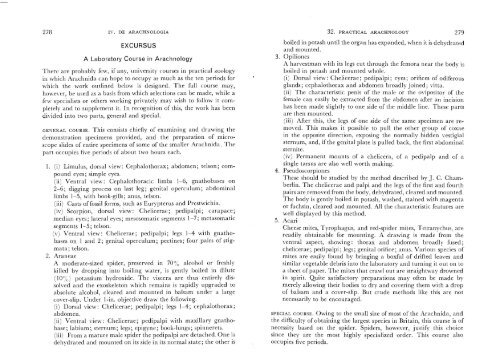Create successful ePaper yourself
Turn your PDF publications into a flip-book with our unique Google optimized e-Paper software.
278 IV. DE ARACHNOLOGIA<br />
EXCURSUS<br />
A Laboratory Course in Arachnology<br />
There are probably few, if any, university courses in practical zoology<br />
in which <strong>Arachnida</strong> can hope to occupy as much as the ten periods for<br />
which the work outlined below is designed. The full course may,<br />
howenr, be used as a basis from which selections can be made, while a<br />
few specialists or others working privately may wish to follow it completely<br />
and to supplement it. In recognition of this, the work has been<br />
divided into two parts, general and special.<br />
GE!':ERAL couRsE. This consists chiefly of examining and drawing the<br />
demonstration specimens provided, and the preparation of microscope<br />
slides of entire specimens of some of the smaller <strong>Arachnida</strong>. The<br />
part occupies five periods of about two hours each.<br />
1. (i) Limulus, dorsal view: Cephalothorax; abdomen; telson; compound<br />
eyes; simple eyes.<br />
(ii) Ventral view: Cephalothoracic limbs 1-6, gnathobases on<br />
2-6; digging process on last leg; genital operculum; abdominal<br />
limbs 1-5, with book-gills; anus, telson.<br />
(iii) Casts offossil forms, such as Eurypterus and Prestwichia.<br />
(iv) Scorpion, dorsal view: Chelicerae; pedipalpi; carapace;<br />
median eyes; lateral eyes; mesosomatic segments 1-7; metasomatic<br />
segments 1-5; telson.<br />
(v) Ventral view: Chelicerae; pedipalpi; legs 1-4 with gnathobases<br />
on 1 and 2; genital operculum; pectines; four pairs of stigmata;<br />
telson.<br />
2. Araneae<br />
A moderate-sized spider, preserved in 70'/c 1 alcohol or freshly<br />
killed by dropping into boiling water, is gently boiled in dilute<br />
(10%) potassium hydroxide. The viscera are thus entirely dissolved<br />
and the exoskeleton which remains is rapidly upgraded to<br />
absolute alcohol, cleared and mounted in balsam under a large<br />
cover-slip. Under 1-in. objective draw the following.<br />
(i) Dorsal view: Chelicerae; pedipalpi; legs 1-4; cephalothorax;<br />
abdomen.<br />
(ii) Ventral view: Chelicerae; pedipalpi with maxillary gnathobase;<br />
labium; sternum; legs; epigyne; book-lungs; spinnerets.<br />
(iii) From a mature male spider the pedipalpi are detached. One is<br />
dehydrated and mounted on its side in its normal state; the other is<br />
32. PRACTICAL ARACHNOLOGY 279<br />
boiled in potash until the organ has expanded, when it is dehydrated<br />
and mounted.<br />
3. Opiliones<br />
A harvestman with its legs cut through the femora near the body is<br />
boiled in potash and mounted whole.<br />
(i) Dorsal view: Chelicerae; pedipalpi; eyes; orifices of odiferous<br />
glands; cephalothorax and abdomen broadly joined; vitta.<br />
(ii) The characteristic penis of the male or the ovipositor of the<br />
female can easily be extracted from the abdomen after an incision<br />
has been made slightly to one side of the middle line. These parts<br />
are then mounted.<br />
(iii) After this, the legs of one side of the same specimen are removed.<br />
This makes it possible to pull the other group of coxae<br />
in the opposite direction, exposing the normally hidden vestigial<br />
sternum, and, if the genital plate is pulled back, the first abdominal<br />
sternite.<br />
(iv) Permanent mounts of a chelicera, of a pedipalp and of a<br />
single tarsus are also well worth making.<br />
4. Pseudoscorpiones<br />
These should be studied by the method described by J. C. Chamberlin.<br />
The chelicerae and pal pi and the legs of the first and fourth<br />
pairs are removed from the body, dehydrated, cleared and mounted.<br />
The body is gently boiled in potash, washed, stained with magenta<br />
or fuchsin, cleared and mounted. All the characteristic features are<br />
well displayed by this method.<br />
5. Acari<br />
Cheese mites, Tyrophagus, and red-spider mites, Tetranychus, are<br />
readily obtainable for mounting. A drawing is made from the<br />
ventral aspect, showing: thorax and abdomen broadly fused;<br />
chelicerae; pedipalpi; legs; genital orifice; anus. Various species of<br />
mites are easily found by bringing a boxful of drifted leaves and<br />
similar vegetable debris into the laboratory and turning it out on to<br />
a sheet of paper. The mites that crawl out are straightway drowned<br />
in spirit. Quite satisfactory preparations may often be made by<br />
merely allowing their bodies to dry and covering them with a drop<br />
of balsam and a cover-slip. But crude methods like this are not<br />
necessarily to be encouraged.<br />
SPECIAL COURSE. Owing to the small size of most of the <strong>Arachnida</strong>, and<br />
the difficulty of obtaining the largest species in Britain, this course is of<br />
necessity based on the spider. Spiders, however, justify this choice<br />
since they are the most highly specialized order. This course also<br />
occupies five periods.















